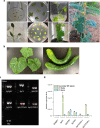Heterologous mogrosides biosynthesis in cucumber and tomato by genetic manipulation
- PMID: 36805532
- PMCID: PMC9938114
- DOI: 10.1038/s42003-023-04553-3
Heterologous mogrosides biosynthesis in cucumber and tomato by genetic manipulation
Abstract
Mogrosides are widely used as high-value natural zero-calorie sweeteners that exhibit an array of biological activities and allow for vegetable flavour breeding by modern molecular biotechnology. In this study, we developed an In-fusion based gene stacking strategy for transgene stacking and a multi-gene vector harbouring 6 mogrosides biosynthesis genes and transformed it into Cucumis sativus and Lycopersicon esculentum. Here we show that transgenic cucumber can produce mogroside V and siamenoside I at 587 ng/g FW and 113 ng/g FW, respectively, and cultivated transgenic tomato with mogroside III. This study provides a strategy for vegetable flavour improvement, paving the way for heterologous biosynthesis of mogrosides.
© 2023. The Author(s).
Conflict of interest statement
The authors declare no competing interests.
Figures






Similar articles
-
Plant Metabolic Engineering by Multigene Stacking: Synthesis of Diverse Mogrosides.Int J Mol Sci. 2022 Sep 9;23(18):10422. doi: 10.3390/ijms231810422. Int J Mol Sci. 2022. PMID: 36142335 Free PMC article.
-
Heterologous Biosynthesis of Health-Promoting Baicalein in Lycopersicon esculentum.Molecules. 2022 May 11;27(10):3086. doi: 10.3390/molecules27103086. Molecules. 2022. PMID: 35630564 Free PMC article.
-
Recent progress on the molecular breeding of Cucumis sativus L. in China.Theor Appl Genet. 2020 May;133(5):1777-1790. doi: 10.1007/s00122-019-03484-0. Epub 2019 Nov 21. Theor Appl Genet. 2020. PMID: 31754760 Review.
-
Allergenicity assessment of genetically modified cucumber mosaic virus (CMV) resistant tomato (Solanum lycopersicon).J Agric Food Chem. 2010 Feb 24;58(4):2302-6. doi: 10.1021/jf903487f. J Agric Food Chem. 2010. PMID: 20102156
-
[Advances in Agrobacterium tumefaciens-mediated transgenic cucumber].Sheng Wu Gong Cheng Xue Bao. 2020 Apr 25;36(4):643-651. doi: 10.13345/j.cjb.190265. Sheng Wu Gong Cheng Xue Bao. 2020. PMID: 32347059 Review. Chinese.
Cited by
-
Bibliometric analysis on the literature of monk fruit extract and mogrosides as sweeteners.Front Nutr. 2023 Aug 29;10:1253255. doi: 10.3389/fnut.2023.1253255. eCollection 2023. Front Nutr. 2023. PMID: 37706210 Free PMC article.
-
Recent Advances in Studying the Regulation of Fruit Ripening in Tomato Using Genetic Engineering Approaches.Int J Mol Sci. 2024 Jan 7;25(2):760. doi: 10.3390/ijms25020760. Int J Mol Sci. 2024. PMID: 38255834 Free PMC article. Review.
-
Post-Ripening and Key Glycosyltransferase Catalysis to Promote Sweet Mogrosides Accumulation of Siraitia grosvenorii Fruits.Molecules. 2023 Jun 11;28(12):4697. doi: 10.3390/molecules28124697. Molecules. 2023. PMID: 37375251 Free PMC article.
References
-
- Tiu Wright L, Nancarrow C, Kwok PMH. Food taste preferences and cultural influences on consumption. Br. Food J. 2001;103:348–357. doi: 10.1108/00070700110396321. - DOI
Publication types
MeSH terms
LinkOut - more resources
Full Text Sources

